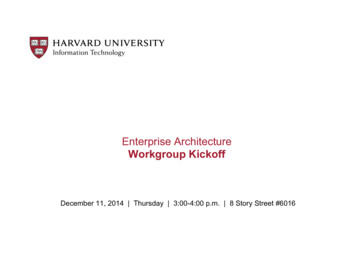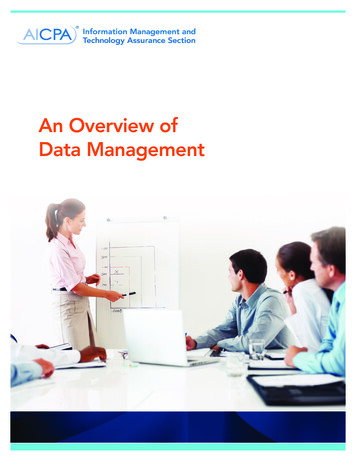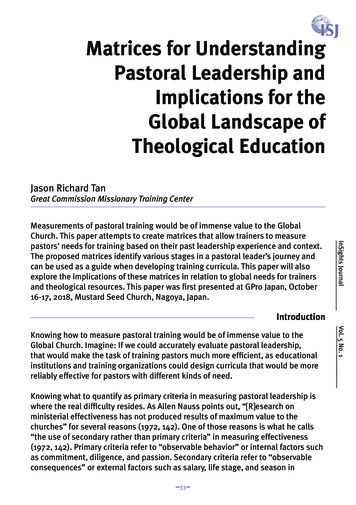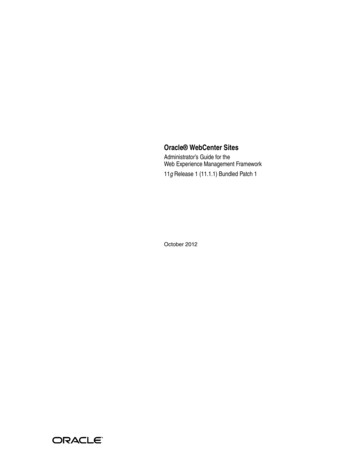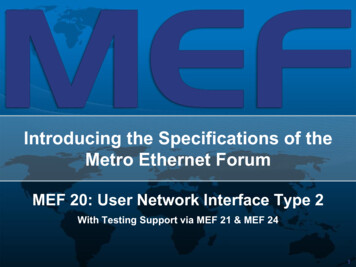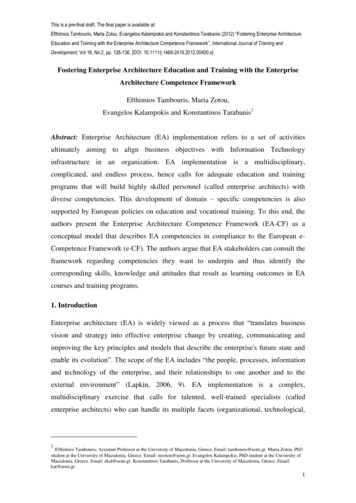
Transcription
This is a pre-final draft. The final paper is available at:Efthimios Tambouris, Maria Zotou, Evangelos Kalampokis and Konstantinos Tarabanis (2012) “Fostering Enterprise ArchitectureEducation and Training with the Enterprise Architecture Competence Framework”, International Journal of Training andDevelopment, Vol.16, No.2, pp. 128-136. [DOI: 10.1111/j.1468-2419.2012.00400.x]Fostering Enterprise Architecture Education and Training with the EnterpriseArchitecture Competence FrameworkEfthimios Tambouris, Maria Zotou,Evangelos Kalampokis and Konstantinos Tarabanis1Abstract: Enterprise Architecture (EA) implementation refers to a set of activitiesultimately aiming to align business objectives with Information Technologyinfrastructure in an organization. EA implementation is a multidisciplinary,complicated, and endless process, hence calls for adequate education and trainingprograms that will build highly skilled personnel (called enterprise architects) withdiverse competencies. This development of domain – specific competencies is alsosupported by European policies on education and vocational training. To this end, theauthors present the Enterprise Architecture Competence Framework (EA-CF) as aconceptual model that describes EA competencies in compliance to the European eCompetence Framework (e-CF). The authors argue that EA stakeholders can consult theframework regarding competencies they want to underpin and thus identify thecorresponding skills, knowledge and attitudes that result as learning outcomes in EAcourses and training programs.1. IntroductionEnterprise architecture (EA) is widely viewed as a process that “translates businessvision and strategy into effective enterprise change by creating, communicating andimproving the key principles and models that describe the enterprise's future state andenable its evolution”. The scope of the EA includes “the people, processes, informationand technology of the enterprise, and their relationships to one another and to theexternal environment” (Lapkin, 2006, 9). EA implementation is a complex,multidisciplinary exercise that calls for talented, well-trained specialists (calledenterprise architects) who can handle its multiple facets (organizational, technological,1Efthimios Tambouris, Assistant Professor at the University of Macedonia, Greece. Email: tambouris@uom.gr. Maria Zotou, PhDstudent at the University of Macedonia, Greece. Email: mzotou@uom.gr. Evangelos Kalampokis, PhD student at the University ofMacedonia, Greece. Email: ekal@uom.gr. Konstantinos Tarabanis, Professor at the University of Macedonia, Greece. Email:kat@uom.gr1
This is a pre-final draft. The final paper is available at:Efthimios Tambouris, Maria Zotou, Evangelos Kalampokis and Konstantinos Tarabanis (2012) “Fostering Enterprise ArchitectureEducation and Training with the Enterprise Architecture Competence Framework”, International Journal of Training andDevelopment, Vol.16, No.2, pp. 128-136. [DOI: 10.1111/j.1468-2419.2012.00400.x]social etc.) In the literature however there is little work focusing on the competencies ofenterprise architects.This article presents the EA Competence Framework (EA-CF), which extends theEuropean e-Competence Framework (e-CF) for Lifelong Learning. The e-CF has beenproposed by the European Committee for Standardization (CEN, 2008) as a commonEuropean language for Information and Communication Technologies (ICT)competencies. The e-CF competencies’ and their associated concepts’ identification hasbeen a joint effort of ICT stakeholders from business, politics and education acrossEurope and the framework’s final results have been recognised in the Communicationof the European Commission on “e-Skills for the 21st Century: FosteringCompetitiveness, Growth and Jobs” (CEN, 2010).Thus, EA – CF complies with a Europe-wide agreed reference for ICT competences forall industry skills. The framework adopts e-CF’s concepts and supplements them withEA – specific concepts in order to provide a complete and in depth understanding of EAcompetencies and to contribute to the successful implementation of EA training andeducation.2. EA TrainingEnterprises that endeavour to prevail in today’s global economy are required toincorporate innovative technologies and business models in order to adapt to the rapidlychanging environment. However, the complexity of these processes brings forthadditional challenges that should be addressed and overcome. To this end, both publicand private organizations have started to implement EA and exploit its ability to notonly govern and facilitate decision-making processes but also to originate new businessopportunities. More specifically, EA acts as a “collaborative force” between thedifferent enterprises components (i.e. business planning, business operations,automation and technological infrastructure) and thus provides a holistic overview ofthe entire enterprise (Schekkerman, 2004).However, due to the variety and complexity of information that an EA entails, itssuccessful implementation is challenging. Hence, constant update on emerging EA specific knowledge should be fostered via academic programs focusing on EA as wellas ongoing training systems within the enterprises (Strano and Remani, 2007).Nevertheless, sole EA comprehension does not sufficiently prepare enterprise architects2
This is a pre-final draft. The final paper is available at:Efthimios Tambouris, Maria Zotou, Evangelos Kalampokis and Konstantinos Tarabanis (2012) “Fostering Enterprise ArchitectureEducation and Training with the Enterprise Architecture Competence Framework”, International Journal of Training andDevelopment, Vol.16, No.2, pp. 128-136. [DOI: 10.1111/j.1468-2419.2012.00400.x]for the daily challenges and tasks they are required to address. More specifically,business, technological, management and social skills should be considered to enhanceenterprise architects’ ability to successfully develop and manage architectures andprovide them with a significant competitive advantage within the enterprise(Steenbergen et al., 2008).Therefore, this gradual incorporation of EA principles within organizations has led to asmall number of EA academic programs and certification institutions. However, theacademic institutions that include courses specializing in EA are still limited and thecorresponding educational material varies, since the design and implementation of thecurricula is individually decided by each institution. Hence, significant differences canbe identified in the EA – related knowledge that is taught and the skills that aredeveloped.To this end, the modern knowledge society requires a closer co-operation betweeneducational institutes and the professional world for the unified determination of thelearning outcomes in terms of knowledge and skills that should be reached, as expressedin the Barcelona European Council (2002). According to Müller (2006), this isn’t whatis happening in universities right now. In contrast, universities teach strictly structuredcourses that passively deliver knowledge without following learning designs that willfoster the development of the associated skills needed in professional life. Therefore,new learning strategies need to be set in motion that will take into consideration thelabour market’s needs and embed corresponding competency – based activities intoexisting teaching programs that will sufficiently train future employees to their highestpotentials (Stoof et al., 2006; Land et al., 2009).2.1 EA Training ProgramsEA training programs are usually seminars that are held by private organizations andprovide EA courses with or without certification possibilities. Each program usuallyteaches a specific EA framework (e.g. Zachman, TOGAF etc). These seminars aim incertifying the comprehension of the EA framework’s concepts and its implementationprocess. Apart from independent certification programs held by large InformationTechnology (IT) companies such as IBM, Capgemini etc (Land et al., 2009), some ofthe most well known training institutes and programs are as follows: The Federated Enterprise Architect Certification Institute (FEACI)3
This is a pre-final draft. The final paper is available at:Efthimios Tambouris, Maria Zotou, Evangelos Kalampokis and Konstantinos Tarabanis (2012) “Fostering Enterprise ArchitectureEducation and Training with the Enterprise Architecture Competence Framework”, International Journal of Training andDevelopment, Vol.16, No.2, pp. 128-136. [DOI: 10.1111/j.1468-2419.2012.00400.x]The FEACI aims to educate enterprise architects by teaching a variety of EAframeworks, such as TOGAF, FEA(F), DoDAF etc. It comprises of twocertification programs and focuses on the development of processionalcompetencies. The Open Group Certified Architect Program (Open CA)The Open CA (former ITAC) program aims to train IT, Business and Enterprisearchitects and foster the development of professional and personal competencies(i.e. skills and knowledge. The Zachman Certified - Enterprise Architect programThe Zachman Certified - Enterprise Architect program aims to educateenterprise architects by teaching the usage of the Zachman Framework. Thistraining program focuses on the delivery of knowledge as well as thedevelopment of technical skills.However, the aforementioned training programs do not follow EA – specific guidelinesfor the determination of the competencies to be fostered and the corresponding learningoutcomes that should result. Therefore, the differentiated material leads to inequalitybetween enterprise architects qualifications and a disjointed EA implementation.2.2 EA Academic ProgramsAcademic programs consist of EA postgraduate programs or individual graduatecourses. Each EA course aims to provide adequate knowledge regarding various aspectsof the domain that may be useful to future enterprise architects. A few universitiesprovide a small sub-group of EA related courses within their departments, whereas onlya handful has postgraduate programs that focus completely on EA, e.g. Royal Melbourne Institute of Technology. Melbourne, Australia – MasterTechnology (Enterprise Architecture) Griffith University, Australia – Master of Enterprise Architecture Brunel University, London, United Kingdom – Enterprise Systems ArchitectureThe limited amount of EA academic programs as well as the disjointed EA materialtaught in both academic and training programs brings forth the need for appropriateguidelines that will enable the homogenous design of EA educational material andcurriculum. EA-CF can provide these guidelines, since the competences it includes areverified Europe-wide and the information regarding the skills, knowledge and attitude4
This is a pre-final draft. The final paper is available at:Efthimios Tambouris, Maria Zotou, Evangelos Kalampokis and Konstantinos Tarabanis (2012) “Fostering Enterprise ArchitectureEducation and Training with the Enterprise Architecture Competence Framework”, International Journal of Training andDevelopment, Vol.16, No.2, pp. 128-136. [DOI: 10.1111/j.1468-2419.2012.00400.x]that enterprise architects need to acquire in order to successfully implement EA areidentified by the experts in the EA domain.3. EA-CFEA-CF is an extended version of the European e-CF with additional concepts thatspecifically characterize EA competencies. The e-CF describes the 36 prominent ICTcompetences that can be applied in all sectors (i.e. private, public, and academia) acrossEurope. According to e-CF “Competence is a demonstrated ability to apply knowledge,skills and attitudes to achieving observable results” (CEN, 2010, 6).Six main concepts are included in e-CF (i.e. Competence area, Competence, Proficiencylevel, Skills, Knowledge and Attitude). The Skill, Knowledge and Attitude concepts canbe considered as learning outcomes that are reached within educational courses andvocational training programs.The EA – specific concepts that were identified and incorporated in e-CF led to thedevelopment of EA-CF by area experts from academia, IT sector and pubic sector withthe XXX project co-funded by the European Union (reference to project is removed toprevent blind-review).5
This is a pre-final draft. The final paper is available at:Efthimios Tambouris, Maria Zotou, Evangelos Kalampokis and Konstantinos Tarabanis (2012) “Fostering Enterprise ArchitectureEducation and Training with the Enterprise Architecture Competence Framework”, International Journal of Training andDevelopment, Vol.16, No.2, pp. 128-136. [DOI: 10.1111/j.1468-2419.2012.00400.x]Fig. 1 The ontology depicting EA-CF’s conceptsThe final EA-CF was modelled as an ontology that contains 10 classes, 13 sub-classes,127 concepts and 30 relationships (see Fig. 1), and includes only 14 out of the 36 ICTcompetences that are considered EA – specific. More specifically, the classes and sub –classes are as follows: Competence: The ability to apply knowledge, skills and attitudes for achievingobservable results. Skill: The ability to carry out managerial or technical tasks. It includes:o Business skillo Technical skillo Legal skillo EA – specific skill. Attitude: The cognitive and relational capacity. It can also be described aspersonality characteristics. Knowledge: The "set of know-what" and can be described by operationaldescriptions. It includes:o Business knowledge6
This is a pre-final draft. The final paper is available at:Efthimios Tambouris, Maria Zotou, Evangelos Kalampokis and Konstantinos Tarabanis (2012) “Fostering Enterprise ArchitectureEducation and Training with the Enterprise Architecture Competence Framework”, International Journal of Training andDevelopment, Vol.16, No.2, pp. 128-136. [DOI: 10.1111/j.1468-2419.2012.00400.x]o Technical knowledgeo EA – specific knowledge. Competence area: The identified ICT business processes (i.e. Plan, Build, Run,Enable and Manage). The areas that are considered EA – related and thereforeare included in the EA- CF ontology as sub – classes of the Competence areaclass are:o Enable areao Manage areao Plan area Proficiency level: The autonomy, behaviour and context complexity of acompetence. Role: The roles of an Enterprise Architect. An Enterprise Architect could act as acommunicator, a leader, a manager, a modeller etc. Each role requires differentsets of competencies. Responsibility: The responsibilities of an Enterprise Architect in every step ofthe EA development process. In meeting these responsibilities, the EnterpriseArchitect needs certain competencies. EA process step: The steps followed for developing an EA. Target Group: The different sectors that require EA competencies development.It includes:o Private: EA related employees related in private sectoro Public: EA related employees in public sectoro Student: University students taking EA relevant courses.The EA – CF development process led to the creation of the final model, which can beobtained as ontology (OWL file) from http://islab.uom.gr/ea owl.owl.4. EA – CF and TrainingA number of frameworks have been adapted to comply with e-CF in order to “facilitatetrans-national mobility for workers and learners and contribute to meeting therequirements of supply and demand in the European labour market” (EuropeanCommission, 2008, 6). Representative examples of good practices in extending e-CF fortraining reinforcement are the United Kingdom developed Skills framework for theinformation age (SFIA), the German Advanced IT Training System (AITTS) and the7
This is a pre-final draft. The final paper is available at:Efthimios Tambouris, Maria Zotou, Evangelos Kalampokis and Konstantinos Tarabanis (2012) “Fostering Enterprise ArchitectureEducation and Training with the Enterprise Architecture Competence Framework”, International Journal of Training andDevelopment, Vol.16, No.2, pp. 128-136. [DOI: 10.1111/j.1468-2419.2012.00400.x]European Certification Model for ICT Professionals (EUCIP). All of these frameworkslink their features with e-CF’s concepts and are implemented in domains such asInformation Technology (IT), Human Resources (HR) and Information Systems (IS) fortraining competencies (CEN, 2010). Similarly, EA – CF endeavours to foster trainingcompetencies specializing in the EA domain.The profession of the enterprise architect is strongly connected with knowledge gainedin higher education as well as with real – world experience gained through practice inthe domain (Land et al., 2009). Therefore, all academic and training programs shouldincorporate competency – based learning strategies for the development of EA –specific competencies. European policies strongly support this shift in trainingprograms, by claiming that “education and training systems should deliver the right mixof skills, including digital and transversal key competencies” (European Commission,2010, 10) and that “labour markets increasingly rely on higher skill levels andtransversal competencies” (Roy, 2010, 11).Currently, limited research is available regarding EA training practices in the public andprivate sectors (Land et al., 2009). However, there are case studies that show thatconstant training significantly enhances enterprise architects’ performance. Morespecifically, Aier and Schelp (2009) and Goh (2006, 126) studied the success factors ofEA in the private sector and conclude that iterated training is fundamental for theenterprise’s sustainable success. Additionally, Steenbergen et al (2008) researched theinfluential factors for EA success in both public and private sectors and concluded thattraining is one of the factors that determine the enterprise’s EA maturity level.EA-CF can act as a facilitator in the training process by providing information regardingknowledge and skills that are associated with the development of EA - specificcompetencies. More specifically, stakeholders from public and private sectors as well asacademics that require the development of a specific competence can consult theframework for the identification of the corresponding skills, knowledge and attitudesthat should act as learning outcomes resulting from an EA course or a vocationaltraining program. Moreover, they can refer to EA-CF for qualification purposes, i.e.when they need to hire enterprise architects or determine an enterprise architect’sexpertise level etc by identifying which knowledge, professional skills and attitudes areessential to an EA competence.In order to better illustrate some of the frameworks uses, we present three examples:8
This is a pre-final draft. The final paper is available at:Efthimios Tambouris, Maria Zotou, Evangelos Kalampokis and Konstantinos Tarabanis (2012) “Fostering Enterprise ArchitectureEducation and Training with the Enterprise Architecture Competence Framework”, International Journal of Training andDevelopment, Vol.16, No.2, pp. 128-136. [DOI: 10.1111/j.1468-2419.2012.00400.x] A public company wants to evaluate its EA team A private company wants to hire enterprise architects A university wants to develop a new course on EAIn the first example, we assume that a public company wants to evaluate its current EAteam. The head of the EA department has knowledge of the competencies the teampossesses and on which level. If there are competencies that are somewhat lackingcompared to others, EA-CF provides information about skills, knowledge and attitudesthe enterprise architects can focus on. If we assume that the lacking competence isInformation Security Strategy Development, the head of HR can consult EA-CF andidentify the corresponding concepts and instances. According to EA-CF, skills such asData Management, Business Modelling and Organizational Design can assist in thedevelopment of the said competence. Moreover, the enterprise architect must acquireknowledge related to Business Practices, Business Needs and Objectives, Domain ofOrganization etc. Finally, Creativity, Leadership and Problem Solving are amongst theattitudes that will enhance the enterprise architect’s efficiency (see Fig. 2).Fig. 2 The Information Security Strategy Development competence in the EA-CFontologyWith this information in hand, the company can develop training material and activitiesthat focus on the competence in question. More specifically, since problem solving andleadership are attitudes that need to be fostered, the public company could customize its9
This is a pre-final draft. The final paper is available at:Efthimios Tambouris, Maria Zotou, Evangelos Kalampokis and Konstantinos Tarabanis (2012) “Fostering Enterprise ArchitectureEducation and Training with the Enterprise Architecture Competence Framework”, International Journal of Training andDevelopment, Vol.16, No.2, pp. 128-136. [DOI: 10.1111/j.1468-2419.2012.00400.x]training program by applying the Problem Based Learning strategy and improve theexisting EA - related lectures by assigning EA – oriented tasks to the employees wherethey will be required to successfully solve given problems and make EA relateddecisions based on scientific arguments.In the second example, we assume that a private company needs to hire qualifiedenterprise architects. The positions to be filled require the competence of IS andBusiness Strategy Alignment (see Fig. 3). To this end, the head of the EA departmentconsults EA-CF in order to identify the skills and the knowledge that the potential staffmust have.Fig. 3 The IS and Business Strategy Alignment competence in the EA-CF ontologySubsequently, the position requirements in the job announcement as well as theinterview questions will focus on examining the acquisition level of some or all of theskills, knowledge and attitudes retrieved from EA-CF. This is a representative examplewhere EA-CF can capitulate on e-CF’s qualification role and act as a tool for successfulEA recruiting.Finally, in the third example, we assume that a university department is interested indeveloping a graduate or postgraduate program in EA. To this purpose, EA-CF candepict which competencies are required to be underpinned and subsequently whatknowledge, skills and attitudes the students must obtain through the courses. Different10
This is a pre-final draft. The final paper is available at:Efthimios Tambouris, Maria Zotou, Evangelos Kalampokis and Konstantinos Tarabanis (2012) “Fostering Enterprise ArchitectureEducation and Training with the Enterprise Architecture Competence Framework”, International Journal of Training andDevelopment, Vol.16, No.2, pp. 128-136. [DOI: 10.1111/j.1468-2419.2012.00400.x]learning styles and strategies can be implemented accordingly for the facilitation of thelearning process. For example, if Business Plan Development will be one of thecompetencies in focus (see Fig. 4), knowledge such as Key EA Concepts and StrategicDirections and Plans, skills such as Modelling Techniques and Organisation Design aswell as Creativity and Abstractionist attitudes could be gained through collaborativelearning strategies (e.g. Think – Pair – Share, Jigsaw, Fishbowl etc) with theincorporation of facilitating tools (e.g. Concept maps, flowcharts, flash cards, Web 2.0communication tools etc).Fig. 4 The Business Plan Development competence in the EA-CF ontologyThis way, EA-CF can foster the development of the target competencies and support thetransformation of training processes into lifelong training mechanisms for EAsuccessful implementation.5. ConclusionsSuccessful competencies development in the private and public sector as well as inacademia builds qualified present and future employees that are more adaptive to themodern society where knowledge rapidly changes and becomes out of date within a fewyears (Arguinis & Kraiger, 2009). This can be successfully achieved through constanttraining of domain – specific competencies using an established reference that complieswith European standards, such as e-CF. Focusing on the EA domain, the authors11
This is a pre-final draft. The final paper is available at:Efthimios Tambouris, Maria Zotou, Evangelos Kalampokis and Konstantinos Tarabanis (2012) “Fostering Enterprise ArchitectureEducation and Training with the Enterprise Architecture Competence Framework”, International Journal of Training andDevelopment, Vol.16, No.2, pp. 128-136. [DOI: 10.1111/j.1468-2419.2012.00400.x]developed EA-CF based on e-CF’s concepts and elaborated on its compliance withEuropean education and training policies as well as on its contribution to the successfulimplementation of EA – specific education and training programs.EA – CF includes 14 out of the 36 ICT competencies of e-CF that were distinguished asEA – related by EA stakeholders of the private and private sector as well as academia.The framework comprises 10 concepts that effectively describe each competence, whilefour of those concepts are further divided into sub – categories to provide a moredetailed portrayal of the competencies.EA-CF’s compatibility with e-CF ensures its compliance with European lifelonglearning policies that promote the development of the identified competencies. Morespecifically, e-CF promotes European co-operation for enhanced education andvocational trainings that foster educational and professional mobility, by identifying anddescribing the competence needs for all sectors, as proposed in the Bologna Process(1999). Therefore, for example, EA-CF can provide reliable and certified information topublic companies when they need to evaluate their EA team on its EA competencesacquisition level. This way, the corresponding knowledge, skills and attitudes that astaff member should possess are identified and thus the companies’ vocational trainingprograms can be customized accordingly. Furthermore, universities that want to developEA courses can identify which competencies should be fostered and gather informationregarding the knowledge that should be delivered through the educational material aswell as the skills and attitudes that should be developed by the students through thelearning process. This also encourages educational institutions to adopt innovative andcompetency – based learning strategies that can sufficiently foster skills and attitudes,resulting in more student – centred EA courses.Moreover, e-CF is consistent with the Lisbon European Council (2000) and theCopenhagen Declaration (2002) which emphasise on the need for recognition andtransparency of qualifications standards, due to its description of the competenciesbased on the European Qualification Framework (EQF) learning outcomes – basedlanguage (European Commission, 2008). Therefore, EA stakeholders, such as privatecompanies, can consult EA-CF for the successful employment of enterprise architects.Subsequently, their recruitment procedures can be customized so that they thoroughlyevaluate the EA – CF concepts (i.e. knowledge, skills and attitudes) that are related tothe required EA competences.12
This is a pre-final draft. The final paper is available at:Efthimios Tambouris, Maria Zotou, Evangelos Kalampokis and Konstantinos Tarabanis (2012) “Fostering Enterprise ArchitectureEducation and Training with the Enterprise Architecture Competence Framework”, International Journal of Training andDevelopment, Vol.16, No.2, pp. 128-136. [DOI: 10.1111/j.1468-2419.2012.00400.x]Future research on EA-CF implementation in real world conditions and their evaluationwith established assessment models would provide beneficial scientific data towardsgood practices that enable successful EA lifelong learning. A closer co-operationbetween academia and enterprises can lead to prolific exchange of expertise and thus toa homogenous version of EA training programs that will facilitate cross – bordermobility for enterprise architects.ReferencesAier S., Schelp. J. (2009). A Reassessment of Enterprise Architecture Service-OrientedComputing.ICSOC/ServiceWave 2009 International Workshops, Stockholm, Sweden, 23.11.2009,Springer, Berlin, LNCS 6275, 2010, pp. onsilium.europa.eu/ueDocs/cms Data/docs/pressData/en/ec/71025.pdfAccessed 17 September 2011CEN. (2010). User Guidelines for the application of the European u/site/objects/download/5999 EUeCF2.0userguide.pdfAccessed 16 September 2011.CEN. (2008). European e-Competence Framework 1.0. – A common Europeanframework for ICT Professionals in all industry wnload/4756 EuropeaneCompetenceFramework1.0.pdf. Accessed 21 June 2011.Confederation of EU Rectors’ Conferences and the Association of EuropeanUniversities. (1999). The Bologna Declaration on the European space for d17September 2011.European Commission. (2010). Youth on the Move initiative. An Agenda for new skillsand jobs: A European contribution towards full employment, Strasbourg, 23.11.2010, p.10.13
This is a pre-final draft. The final paper is available at:Efthimios Tambouris, Maria Zotou, Evangelos Kalampokis and Konstantinos Tarabanis (2012) “Fostering Enterprise ArchitectureEducation and Training with the Enterprise Architecture Competence Framework”, International Journal of Training andDevelopment, Vol.16, No.2, pp. 128-136. [DOI: 10.1111/j.1468-2419.2012.00400.x]European Commission. (2008). European Qualifications Framework for LifelongLearning. broch en.pdf Accessed 17September 2011.European Commission. (2002). The Copenhagen 25 en.pdf Accessed 17 September 2011.Goh, B. (2006) Intelligent enterprises for construction: bridging the technology andknowledge gaps through innovation and education, in Research and Practical Issues ofEnterprise Information System, International Federation for Information ProcessingVol. 205, Boston, MA: Springer, 119–131.Land, M. O., Proper, E
provide EA courses with or without certification possibilities. Each program usually teaches a specific EA framework (e.g. Zachman, TOGAF etc). These seminars aim in certifying the comprehension of the EA framework’s concepts and its implementation process. Apart from independent



